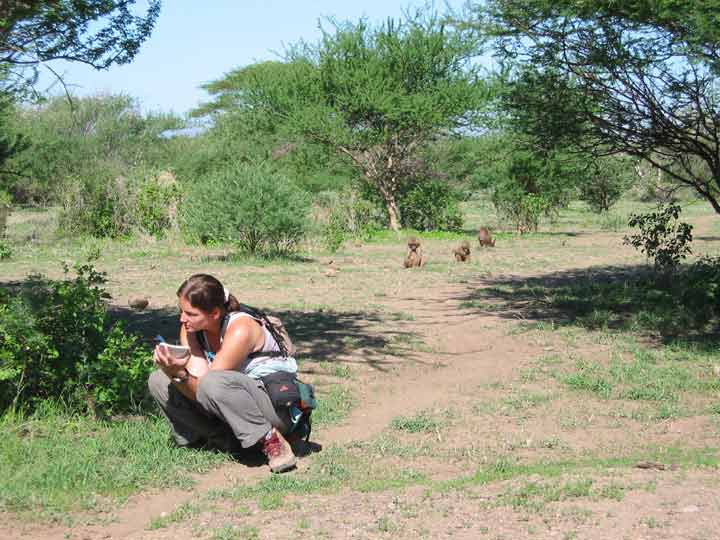

Social Behavior and Reproductive Strategies of Female Hamadryas Baboons (Papio hamadryas hamadryas) in Ethiopia
My dissertation research focused on the role of female behavior in the social organization of wild hamadryas baboons. The site for this project was the Filoha outpost of the Awash National Park in Ethiopia, where behavioral observations, including 10-minute scan samples, continuous focal samples, and ad libitum observations, took place over fourteen months between October 1996 and September 1998. Most aspects of the behavioral ecology, reproductive parameters, and social structure of this population were found to be similar to those of other hamadryas populations. Patterns of social interaction differed, however, in that the "star-shaped" sociogram previously attributed to hamadryas one-male units did not characterize this population.
At Filoha, females varied widely in their patterns of association and interaction with all age-sex classes of individuals. Females interacted socially with other females about as much, on average, as they did with their leader males. The number of females in a unit was positively correlated with the tendency of its females to interact with other females. Females who spent social time with other females did so at a relatively equal frequency whether or not their leader male was available for social interaction at the time. The differentiated female social relationships found in this study, combined with genetic data and evidence from other studies, suggested that levels of relatedness among hamadryas females were higher than had previously been assumed and that pairs of hamadryas females who interacted the most may have done so because they were closely related.
Results from this study also suggested that, while females may have had preferences for some males over others, and occasionally exercised those preferences, a hamadryas female’s main interest lay in maintaining a strong association with her leader male, who could provide protection for both herself and her offspring. Observations of kidnappings by non-leader males and protection of infants by leader males suggested that the behavior of non-leader males toward infants had the potential to lead to injury or death and that the protection of a female’s leader male was critical to infant survival.
Publications from dissertation research:
Swedell, L. (2000) Two takeovers in wild hamadryas baboons. Folia primatologica 71: 169-172.
Swedell, L. (2002a) Affiliation among females in wild hamadryas baboons (Papio hamadryas hamadryas). International Journal of Primatology 23: 1205-1226 (doi:10.1023/A:1021170703006).
Swedell, L. (2002b) Ranging behavior, group size, and behavioral flexibility in Ethiopian hamadryas baboons (Papio hamadryas hamadryas). Folia primatologica 73:95-103 (https://doi.org/10.1159/000064787).
Swedell, L. (2006) Strategies of Sex and Survival in Hamadryas Baboons: Through a Female Lens. Upper Saddle River, NJ: Pearson Prentice Hall.
Swedell, L. & Tesfaye, T. (2003) Infant mortality after takeovers in wild Ethiopian hamadryas baboons. American Journal of Primatology 60: 113-118 (https://doi.org/10.1002/ajp.10096).
Swedell, L. & Saunders, J. (2006) Infant mortality, paternity certainty, and female reproductive strategies in hamadryas baboons. IN Reproduction and Fitness in Baboons: Behavioral, Ecological, and Life History Perspectives,L. Swedell & S. Leigh, eds. New York: Springer, pp. 19-51 (doi: 10.1007/978-0-387-33674-9_2).
Schreier, A. & Swedell, L. (2009) The fourth level of social structure in a multi-level society: ecological and social functions of clans in hamadryas baboons. American Journal of Primatology 71: 948-955 (https://doi.org/10.1002/ajp.20736) .
Swedell, L. & Schreier, A. (2009) Male aggression towards females in hamadryas baboons: conditioning, coercion, and control. IN Sexual Coercion in Primates and Humans: An Evolutionary Perspective on Male Aggression Against Females, M. Muller and R. Wrangham, eds. Cambridge: Harvard University Press, pp. 244-268.